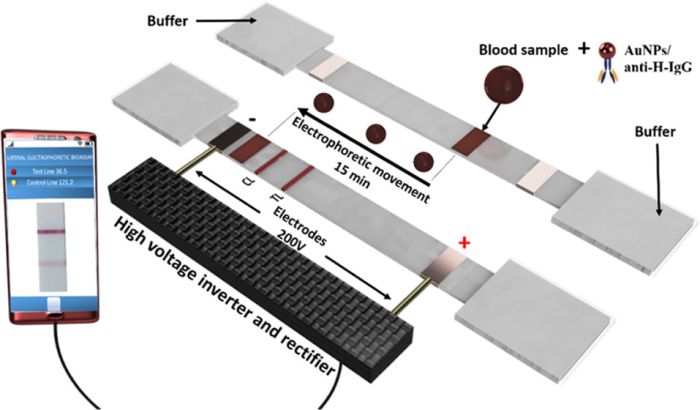Thursday, 10 June 2021
Novel biosensing platform for point-of-care analysis of complex samples without pretreatment
A paper published in “Analytical Chemistry” describes an enhanced biosensing platform based on lateral-flow-assay (LFA) for point-of-care analysis. Cheap, easy to use and portable as LFA, this paper-based electrophoretic bioassay (PEB) allows performing tests on viscous samples, as whole blood, without the need for pretreatment steps. This research was developed by members of the ICN2 Nanobioelectronics and Biosensors Group.

Point-of-care (POF) testing devices are portable systems for quick and reliable diagnostic, which are able to analyze organic samples (such as urine) and provide lab-quality results in short time. These advantages, together with their ease of use and low cost, have spurred the development of various technologies for POC. Among them, lateral flow assays (LFAs) are certainly the most widely used and applied in various fields, from environmental and food monitoring to health care.
Lateral flow assays-based tests are extremely convenient for the end-user, since they are one-step only and no special training is needed to utilize them. The low fabrication cost makes them attractive for developers and producers too. However, they are not as a good platform for analyses requiring pretreatment of the sample, because it would imply additional steps that cannot be easily implemented in the device and performed by a non-trained user. These limitations preclude the application of LFAs to cases such as, for example, the detection of biomarkers at low concentrations in complex media, including blood.
In a paper published in Analytical Chemistry, a sensing platform for whole blood samples analysis is proposed, which is based on LFA but takes advantage of electrophoresis to perform sample treatment. Named paper-based electrophoretic bioassay (PEB), this system retains the structure and benefits of LFAs, while relying on electrophoresis instead of capillary force to move the blood along the device. This research was coordinated by ICREA Prof. Arben Merkoçi, leader of the ICN2 Nanobioelectronics and Biosensors Group; first authors of the paper are Dr Amadeo Sena-Torralba and Dr Ruslán Álvarez-Diduk.
Electrophoresis is the motion of charged particles under the influence of an electric field, i.e. when a voltage is applied between two electrodes. It allows separating molecules in a free solution or in a medium (paper or gel), thanks to their different mobility, which is determined by various parameters (size, shape, charge, temperature). The authors of this study used a paper strip as in standard LFAs, but they added two copper electrodes for applying voltage, which can be supplied by means of a smartphone battery.
As explained in the article, the PEB was able to guarantee the flow of blood along the cellulose membranes of the device and to separate different types of particles. It was also validated for the detection of human antibodies (immunoglobuline G, H-IgG) in undiluted and no-pretreated blood samples. These excellent results prove that PEB can handle media as whole blood, serum and other viscous solutions, without the need for sample pretreatment or washing steps. In addition, a smartphone based system was developed to control the electrophoresis and read out the produced optical signals. These characteristics make of PEB a remarkable platform for point-of-care diagnostics, in particular for the detection of low-concentration target-molecules in complex media.
Reference article:
Amadeo Sena-Torralba, Ruslan Alvarez-Diduk, Claudio Parolo, Helena Torné-Morató, Alexander Müller, and Arben Merkoçi, Paper-Based Electrophoretic Bioassay: Biosensing in Whole Blood Operating via Smartphone. Anal. Chem. 2021, 93, 6, 3112–3121. DOI: 10.1021/acs.analchem.0c04330

